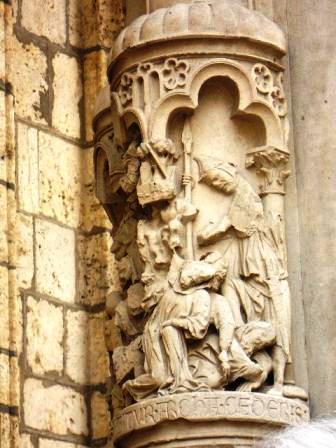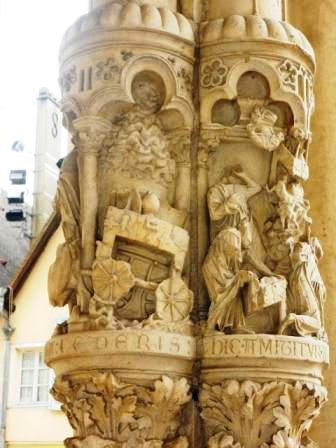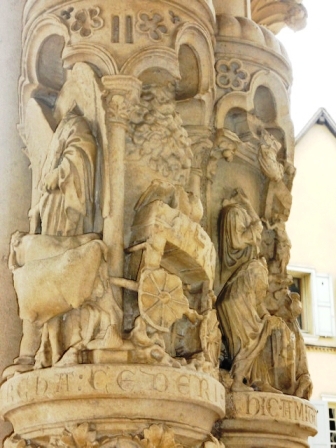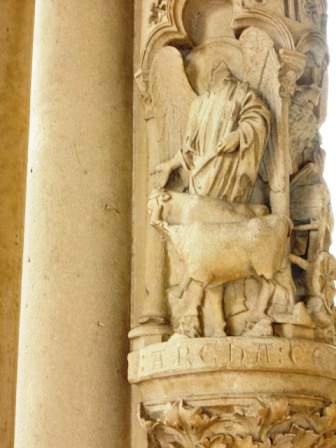Louis Charpentier, The Mysteries of Chartres Cathedral, Avon Books, New York, 1975.
The Mysteries of Chartres Cathedral has remained a unique and intriguing work, widely sold today in the bookshops on the cathedral square in Chartres. Experiencing the impact of the interior of the cathedral, Charpentier asks, “What then was this magic I felt so near to understanding?” The secrets of Chartres are challenging to penetrate today, according to Charpentier, because of the gap “between the men of that time and ourselves, a gulf in which a form of civilization had disappeared.”
The mysteries of Chartres remain usually hidden to contemporary men and women because, in Charpentier’s words, “we remain trapped in our prefabricated view of the past.” Chartres cathedral, he emphasizes, was “brought into being by men who knew what they were about.” For the past thousand years, and likely longer, pilgrims have, Charpentier recounts, made their to Chartres “in order to reach at least once in their lives a place where divinity dwells.”
To Charpentier, the present cathedral resembles a vast musical instrument, its stones in a state of constant tension that its builders understood how to “tune” like harp strings. Poet Paul Claudel wrote that the masonry of Chartres was so taut “that you could make it ring with a fingernail.” When later towers and a chapel were added to the original cathedral, “immense pains were taken to in no way deaden the resonance of the structure.” Gothic architecture, Charpentier tells us, “used dynamic pressures to direct forces upward.” The great gothic cathedrals were solidly grounded in the forces of the earth while simultaneously soaring into the heavens. The result was perhaps the finest vessel ever constructed for passage into transcendental dimensions.

Charpentier believes the Order of Knights Templar was integrally linked to the construction of Chartres. During their early years in Jerusalem f0llowing the First Crusade, the Templars were immersed in excavations beneath the ruins of Solomon’s Temple searching for the Ark of the Covenant. Charpentier believes the Templars may have found this long-lost treasure and then returned with it to France.

One of the pillars of the north portico of the cathedral is emblazoned at its crown with carvings of the Crusades, the recovery of the Ark from the ruins of Solomon’s Temple, and subsequent transport of the Ark. In Latin beneath these images is the carved inscription, “Here things take their course; you shall work through the Ark.” Among the contents of the Biblical Ark were the “Tables of the Law”. These Tables of the Law may have set out underlying principles of the creation, including the secrets of sacred geometry. These same mathematical principles, Charpentier believes, may have been utilized again at Chartres.

The guild of craftsmen most closely involved in the construction of the cathedral were known as the “Children of Solomon.” The full name of the Templars was the “Order of the Poor Knights of the Temple of Solomon”. Charpentier believes the Templars may have contributed substantial support to the creation of Chartres and perhaps secreted their most valuable and potent possession, the Ark of the Covenant, below the cathedral.

Charpentier sets out in impressive detail the geometrical matrix of the cathedral and its relationship to the ordered unfoldment of geometrical forms. He cites parallels between the dimensions and ratios of Chartres and those of the Great Pyramid and sees in the underlying design of the cathedral “the search for a gate, a key to the passage from one world to another.” Exodus XXV: 21-22 describes God as telling Moses, regarding the “mercy seat” atop the Ark, “In the Ark, thou shalt put the testimony that I shall give three. And there I will meet with thee, and I will commune with thee.” Many have experienced such a communion with the divine within Chartres Cathedral. The builders of Chartres sought to make this experience accessible for all who entered their cathedral.

Charpentier directs attention as well to the unique qualities of the stained glass in the great windows of the cathedral. The extraordinary qualities of the original 12th century stained glass of the Ile de France have struck all who have experienced it. “This glass,” Charpentier writes, “does not react to light like ordinary glass.” It “seems instead to be transformed into a precious stone that does not so much let the light pass as itself become luminous.” The stained glass windows of Chartres were, Charpentier maintains, “a product of high science, a product of alchemy,” capable of generating “astonishment.”
“Chartres is a means of passage from one world to another; a bridge between two worlds. Unless he or she is totally impervious, whoever enters the cathedral is saturated with an energy and celestial harmony come alive in matter. They become no longer quite the same man or woman. The old crucible has still not lost its power.”